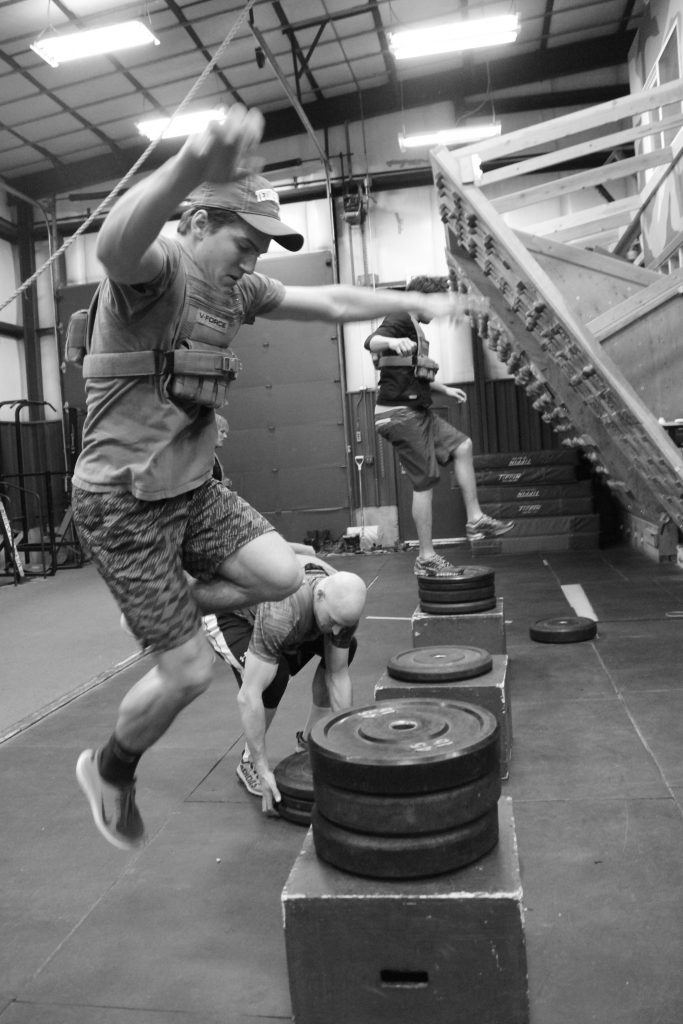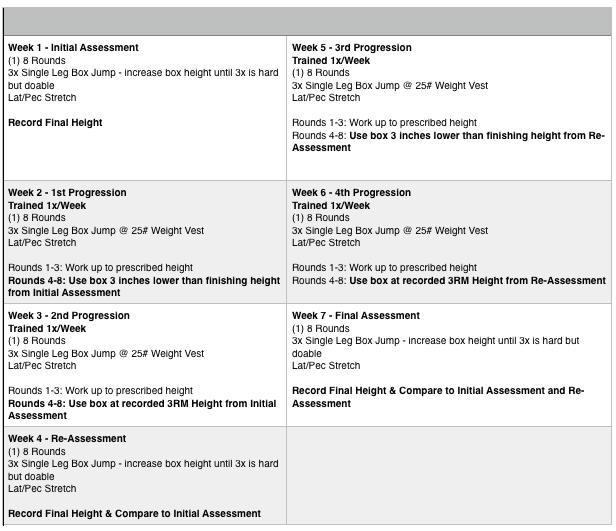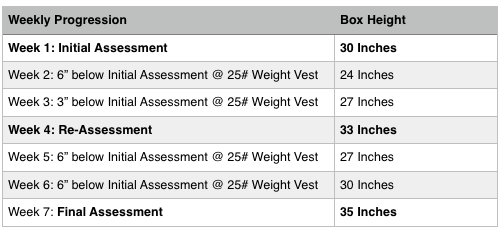
By Charles Bausman
Our tactical Lab Rats recently completed a cycle that emphasized single limb (unilateral) strength and power development. As we developed the cycle, we needed an exercise that would train power and fit within the single-limb construct. We chose the Single Leg Box Jump for our power exercise. This article examines our experience in implementing the movement.
Exercise Description
The Single Leg Box Jump
The Single Leg Box Jump begins with the athlete standing on one foot. The athlete can not step into the jump, but they are encouraged to swing their arms and non-jumping leg to create momentum.
Ideally, the athlete lands softly and quietly, which demonstrates control on the landing. The athlete should be able to land with the same kind of extension of the hips as when they initiated the jump. Simply put, an athlete’s jump and landing should look similar. After each jump, the athlete will step down and reset to do it again.
Assessment and Progression Methodology
Week 1 – Initial Assessment: we had the athlete work up to their 3 Repetition Max (3RM), using max height in inches as the measurement. The athlete conducted 3 jumps on each leg (6x total jumps) with no load and recorded the results. We used 10# bumper plates, which are 1” in width, to steadily increase the height. This incremental approach increased the athlete’s confidence as they prepared to progress the exercise.
If the athlete had uneven results on one leg compared to the other, such as an athlete recording 20” on the left leg and 24” on the right leg, we recorded the lesser number to be used in the follow on progression.
In the weeks between assessments, the athlete would train the Single Leg Box Jump once a week with a 25# weight vest. The weight vest was used to train and develop additional velocity (Force x Velocity = Power) by forcing the athlete to overcompensate in relation to the added load in an explosive, hip driven movement.
Using an adapted Big 24 methodology, the athlete worked up to an assigned height by Round 4 which progressed week by week.

Week 2 – First Progression: The athlete wearing the weight vest, worked up to a height which was 6” below their final assessment height by Round 4. All remaining rounds were completed at that height, with a mobility exercise completed between efforts for the rest period.
Week 3 – Second Progression: The lab rats progressed to 3” below their final assessment height for rounds 4-8 wearing the 25# weight vest.
Week 4 – Re-Assessment: The athletes re-assessed to find their new 3RM.
Week 5-7: The progression was completed again over the next three weeks based on the re-assessment numbers. Week 7 was the final assessment to record their 3RM and compare them to previous assessment scores.
For example, the following chart details what a athletes progression would look like based on assessment results:

Scaling
We did not have any female athlete’s available to test this progression, so scaling wasn’t required. Female athletes should use a weight vest at 10# using the same progression.
Results, Athlete Considerations, and Safety
We were surprised by the increase of results over the 7-week cycle. As displayed by the chart above, all athletes experienced an assessment increase, ranging from 12-38%.

The athletes were able to make all of their progressions throughout the cycle with both legs, a positive indicator that the increases in height with added weight were not too aggressive. When the progression works, as it did with this cycle, it has the added benefit of increasing the athlete’s confidence week by week.
The athletes were excited by the results, but we need to temper the excitement with the realities of the cycle. Much of our training uses traditional bilateral barbell movements, not the unilateral (single leg) emphasis trained in this cycle.
With any new program that utilizes unfamiliar exercises, the athlete will experience a steep increase in performance before they begin to plateau. This was demonstrated by the percentage increase following each assessment. The greatest percentage increase occurred during the Re-Assessment and leveled out by the Final Assessment.
With that said, the Single Leg Box Jump certainly seems to have benefit in developing power regardless of natural athleticism.
Athleticism
Athleticism is a major factor in assessing and progressing this exercise. We found that the more athletic the individual is, the more aggressive and confident they are during initial assessments.
The athletic individual must be tempered initially, as he had a greater likelihood of pushing themselves too far and injuring themselves. Conversely, the less athletic individual usually can be encouraged to attempt a slightly higher jump while still mitigating risk.
It’s interesting to compare the results of our lab rats based on athleticism. Eric and Gabe are both phenomenal athletes. Eric is in his mid-20’s and was a dual-sport collegiate athlete. Gabe is 19, and was an all-state football player at the local high school. The increases over the cycle were smaller, as their initial assessment was significantly higher.
Ross and Will are both good athletes, but not great. Both are in their mid-20’s and have outdoors focused jobs. Their initial results were lower but increased dramatically as they gained confidence in the movement.
By the end of the cycle, all four athletes’ assessment results were much more similar. The progression seems to have mitigated the athletic advantage of Eric and Gabe, as Ross and Will gained confidence in the movement.
Safety Considerations
The exercise does have safety concerns, especially when done with a weight vest. One athlete took a fall trying to land a jump. He shook it off, but it shows the associated risk.
The athlete and coach should be conservative when increasing height and athlete capabilities in conducting the exercise with additional load.
Improving Body Mechanics
Most of our Lab Rats have experienced a leg injury of some sort in the past, and it was obvious when they approached the box. Even the difference between the dominant and nondominant leg was apparent. The athlete had a mental hesitancy with one leg over the other, and some initial variation in max height results as they could jump higher on one leg in comparison to the other.
As the cycle continued, that variation disappeared. The Lab Rats were able to complete all rounds and reps with equal results in terms of height. This would indicate a positive training adaptation as their body mechanics became more equalized between limbs.
We will likely continue to program in unilateral, single-limb movements to develop strength and power in conjunction with bilateral movements. As a classification, the Single Leg Box Jump would fall under a Total Body exercise under our Total, Lower, Upper (TLU) format.
As we move forward, we have several other questions which we’d like to research:
- Can we duplicate results with another single limb power exercise, specifically the Push Press?
- How does the Single Leg Box Jump as a Total Body exercise compare to classic bilateral power exercises such as the Hang Power Clean? Could we determine an equal weight, rep scheme, and progression to compare assessment results between two groups of athletes, similar to our Power Clean vs. Power Snatch study?
Questions? Email coach@mtntactical.com
Comments, Feedback? Please enter your comment below.
You Might Also Like Mini Study: Strength Emphasis and Hybrid Programming Beat Endurance Emphasis to Improve Ruck Performance
STAY UPDATED
Sign-up for our BETA newsletter. Training tips, research updates, videos and articles - and we’ll never sell your info.
